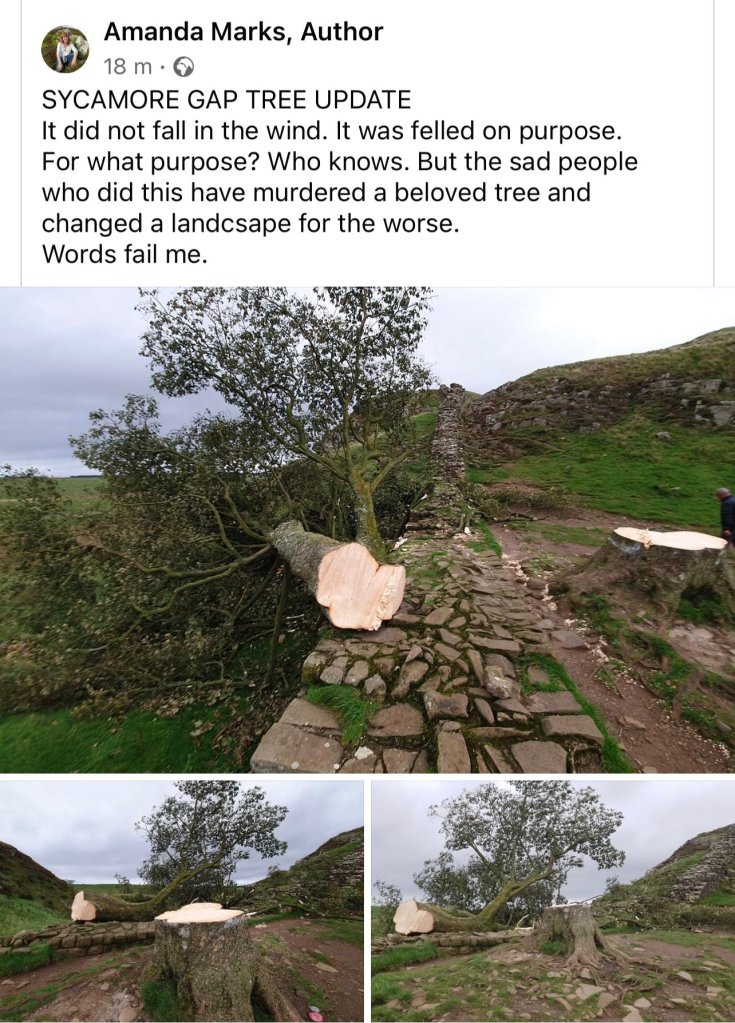The residents of Northumberland, and fans of the county’s stunning scenery around Hadrian’s Wall, woke up to devastating news this morning, as they discovered that the Sycamore Tree nestled in a dip along the wall near Twicebrewed has been felled.
The tree, which led to the spot it stood in becoming known as The Sycamore Gap, was discovered on it’s side, lying across the ancient ruins of the Roman Wall, by Amanda Marks, an author who happened to be staying nearby. Her Facebook post (below) soon went viral among local interest groups focused on the Wall and local towns of Hexham and Haltwhistle.

Believed to have been 300 years old, the Sycamore tree (Acer pseudoplatanus) is the surviving member of what was once a small cluster of trees in that spot along the Wall, the ancient border between Roman Britain and Scotland. It was named ‘Britain’s Favourite Tree’ in 2016 and was the subject of countless photographs, both amateur and professional. You can read more about history of the tree here.

Photo credit: Steven Lomas.
The tree became a much more famous landmark following this scene in the 1991 blockbuster Robin Hood: Prince of Thieves, a Hollywood retelling of the Robin Hood legends starring Kevin Costner, Morgan Freeman, Mary Elizabeth Mastrantonio and Alan Rickman.
The film brought even more tourism to an already popular spot for walkers and fans of Romano-British history.
At present, it is claimed hat the tree was damaged by the winds from Storm Agnes, which blew through the region on Wednesday night and into the early hours of Thursday morning. As a result, the tree may have had to be cut down for safety purposes. Yet looking at the pictures of the felled tree above, many argue that the truck is not showing any signs of storm damage. In fact, the only damage that CAN be determined is the very clean chainsaw cut running through the centre of the trunk.
Furthermore, several local residents are questioning why the tree has been left lying on top of the Wall itself? Historic England, who manage and maintain the sections of Hadrian’s Wall which remain, have long asked walkers and visitors to refrain from walking on to of the wall itself, to prevent further wear and damage to the monument, and the route has more than one sign reminding people of this fact.
Consequently, many believe that the tree has bee cut don in a mindless act of vandalism. As soon as more information becomes available, I will update this post.
Update (5th of October 2023): It has been confirmed that this incident was a deliberate act if vandalism. Local police arrested a 16 year old boy and a man in his sixties in the days following the felling. Both were released, without any charges being pressed at this point, and their investigation continues.
Whatever the reason, it’s a truly sad day for Northumberland. Already, the loss of this iconic tree has provoked sadness and rage amongst those who live close to it, and those who have walked past it on their route along the Wall. Hopefully we will find out exactly why this tree was felled, and if it was a mindless act of vandalism, then suitable measures are taken.
Trees were an important part of Celtic culture (indeed, the alphabet system used trees to differentiate and help organise their letters). In cultures all over the world, trees play an important part, from the Trees if Life & Knowledge in the Garden of Eden to the World Tree in Norse mythology. I believe trees have continued to play an important part in our psyche, hence the huge outpouring of grief in the local area and around the United Kingdom, and even among fans of Hadrian’s Wall around the world.
What happens to the felled tree now, and what might replace it at the Gap itself, remain to be decided. Memories can be shared at a special room set up at The Sill, a local visitor centre very close to the site of Sycamore Gap. More information can be found here.

